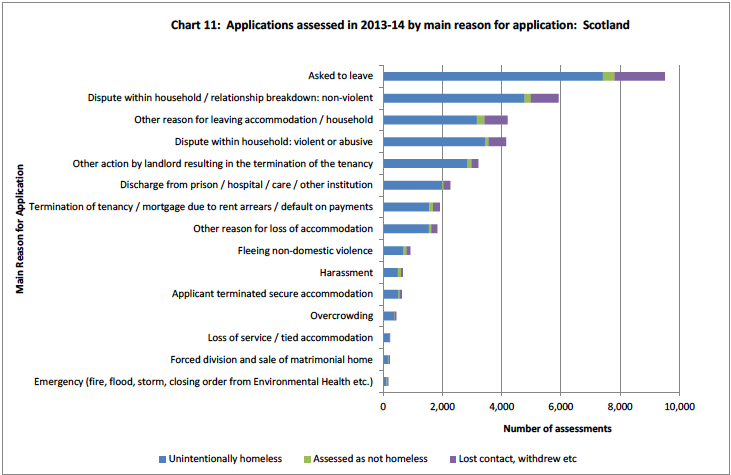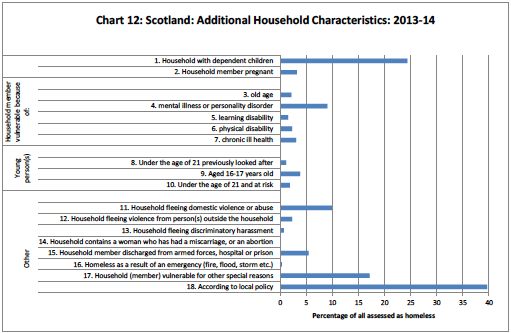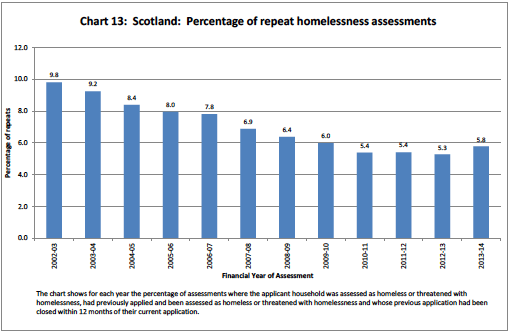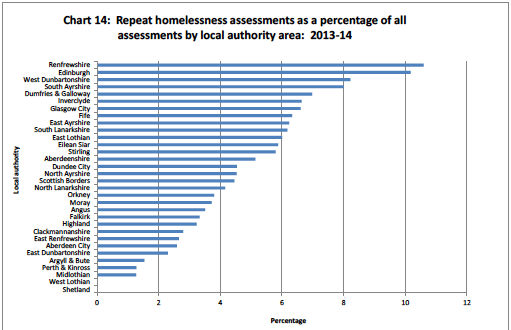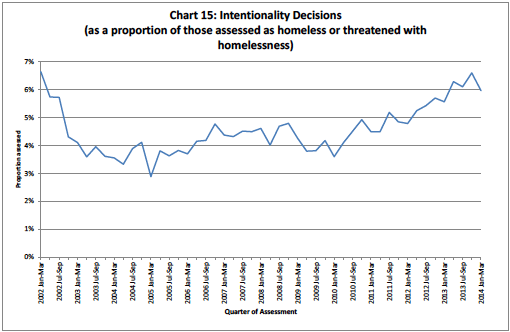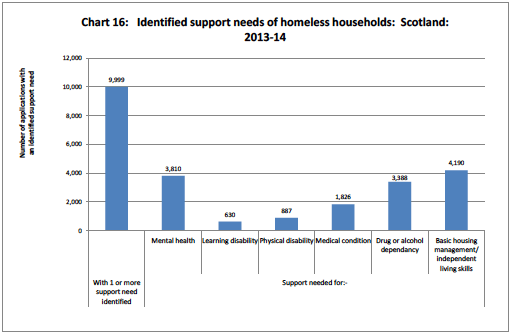Operation of the Homeless Persons Legislation in Scotland: 2013-14
This bulletin provides information on homelessness applications, assessments and outcomes to 31 March 2014. It includes information on the characteristics of applicant households, local authority assessments and the action taken in respect of cases that were concluded. Snapshot data on households in temporary accommodation at 31 March 2014 are also presented.
4. Assessments (Table 1 And Table 6a to Table 11 and Chart 11 to Chart 16)
4.1. Table 1 provides the main summary statistics on the progress of homelessness applications, analysed by the year in which the application was received by the council. However, it takes time for councils to assess a homelessness application. As a consequence, 1,341 applications in 2013-14 have yet to be assessed.
4.2. Of the 36,359 assessments in 2013-14, 29,326 were assessed as homeless or potentially homeless, a reduction of 2,835 (9%) on 2012-13. (Table 1c).
Abolition of Priority Need test
4.3. In November 2012 the Scottish Parliament approved the Homelessness (Abolition of Priority Need Test) (Scotland) Order 2012. This meets the homelessness commitment and ensures that from 31st December 2012 onwards, local authorities no longer apply the priority need test to homeless households. As a result all unintentionally homeless households in Scotland are entitled to settled accommodation. With the priority need test now abolished, information on this aspect of the homelessness legislation is no longer collected.
Reasons for applying as homeless, for applicants which proceeded to a homelessness assessment
4.4. For those reaching the homelessness assessment stage, relationship breakdown is the main cause for applying as homeless. This is reflected in the high numbers of applicants assessed who cite a dispute within the household (28% of all applications in 2013-14) or being asked to leave (25% of 2013-14 applications). (Table 6c and Chart 11). Rent arrears or mortgage default account for around 5% of all homelessness assessment in 2013-14, while 7% of assessments are from those leaving prison/ hospital/ care or some other institution.
4.5. Councils record additional household characteristics for households assessed as homeless, even though they no longer form part of the formal homelessness assessment decision. Councils identify at least one characteristic, but more than 1 characteristic can be given.
4.6. The characteristics[3] in 2013-14 were that the household had dependent children (24% of all assessed as homeless), the household was fleeing domestic violence or abuse (10%), mental illness or personality disorder of a household member (9%) and a household member vulnerable for other special reasons (17%). (Chart 12).
4.7. In 2013-14, 40% of priority assessments were made 'according to local policy'. Following the abolition of the priority need test, this is a 'catch-all' reason indicating that the applicant doesn't fall into any of the other additional characteristic groups.
Repeat homelessness
4.8. The percentage of homeless assessments identified as repeat cases (i.e. where a previous application from the household had been closed less than 12 months before the current assessment [4]) has fallen from 9.8% in 2002-03 to 5.8% in 2013-14 (Chart 13).
4.9. Comparing rates of repeat homelessness by household type, 8% of assessments by single males were repeat applications, 6% of assessments by single females were repeats, while single parents and couples with or without children had lower rates of repeat homelessness.
4.10. The rate of repeat homelessness varies by local authority area, from 10.6% in Renfrewshire to 0% in Shetland and West Lothian (Chart 14).
Intentionality Decisions
4.11. Cases assessed as homeless (or threatened with homelessness) are also tested as to whether they made themselves homeless intentionally. Chart 15 shows the proportion of such cases assessed as intentionally homeless or threatened with homelessness. For Scotland, important points to note are:
- The proportion of cases assessed as intentionally homeless or threatened with homelessness has been increasing - from 3% during January-March 2005 to 6% during January-March 2014.
- The number assessed as intentionally homeless has fallen back slightly. The highest level since January-March 2002 was seen in April-June 2013 (485 intentionally homeless decisions). In the most recent quarter (Jan-Mar 2014) the numbers have fallen back slightly with 439 cases assessed as intentionally homeless. This compares with a low of 233 cases during January-March 2005.
- Although the numbers are small, the number of intentionality decisions has been increasing, whilst the number of applications and homeless assessments have both been reducing.
4.12. Prior to the abolition of the priority need test, only those assessed a homeless [or threatened with homelessness] and in priority need would have proceeded to the intentionality test. However, following abolition, all those assessed as homeless [or threatened with homelessness] are tested for intentionality. As a result, more homeless applicants may be found to be intentionally homeless, and therefore the increases seen in Chart 15 are perhaps a reflection of this. Support needs of homeless households
4.13. Of the 29,326 households assessed as homeless in 2013-14, 9,999 (34%) were assessed as having one or more support needs. (Table 7 and Chart 16). Of those with support needs, 3,810 (13% of all assessed as homeless) required support because of mental health, 4,190 (14%) required support on skills for independent living and 3,388 (12%) required support because of alcohol or dependency problems. These proportions are unchanged from 2012-13.
4.14. Housing Support Services (Homelessness) (Scotland) Regulations 2012 were approved by the Scottish Parliament in November 2012, and came into force on 1st June 2013. These regulations were approved by the Scottish Parliament in November 2012, and came into force on 1st June 2013. These regulations place a duty on local authorities to assess the need for housing support services as prescribed in regulations for any applicant the local authority has reason to believe may be in need of housing support services and who is unintentionally homeless or threatened with homelessness. If an assessment of a need for support is made, local authorities must ensure that service is provided to the person who needs it. Information on the impact of the regulations is discussed in the section on Housing Support Regulations and Table 11.
Contact
Email: Andrew Waugh or Ian Morton
There is a problem
Thanks for your feedback
